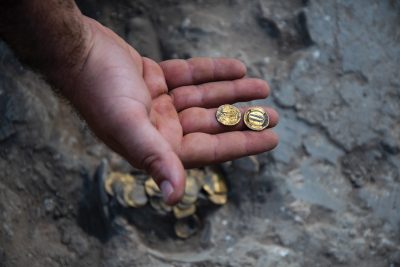
 A rare coin hoard from the Abbasid period, dating around 1,100 years ago, was uncovered by a group of youths volunteering before their army service in an archaeological excavation carried out by the Israel Antiquities Authority (IAA).
A rare coin hoard from the Abbasid period, dating around 1,100 years ago, was uncovered by a group of youths volunteering before their army service in an archaeological excavation carried out by the Israel Antiquities Authority (IAA).
According to the directors of the excavation, Liat Nadav-Ziv and Dr. Elie Haddad of the IAA: “The hoard, deliberately buried in the ground in a clay jar, contained 425 gold coins, most of which date to the Abbasid period. The person who buried this treasure 1,100 years ago must have expected to retrieve it, and even secured the vessel with a nail so that it would not move. We can only guess what prevented him from returning to collect this treasure. Finding gold coins, certainly in such a considerable quantity, is extremely rare. We almost never find them in archeological excavations, given that gold has always been extremely valuable, [and is usually] melted down and reused from generation to generation. The coins, made of pure gold, were found in excellent condition, as if buried the day before. Their finding may indicate that international trade took place between the area’s residents and remote areas.”
According to Dr. Robert Kool, a coin expert at the IAA, “The coins are made of pure gold—24 carats. The total weight of the hoard is about 845 grams [30 oz] of pure gold, a significant amount of money in those days. For example, with such a sum, a person could buy a luxurious house in one of the best neighborhoods in Fustat, the enormous wealthy capital of Egypt in those days. From an initial examination of the coins, most of them date to the end of the ninth century AD. During this period, the region was part of the vast Abbasid Caliphate, stretching from Persia in the east to North Africa in the west, and whose center of government was in Baghdad, Iraq. The hoard consists of full gold dinars, but also, what is unusual, it contains about 270 small gold cuttings, pieces of gold dinars cut to serve as ‘small change.’”
The cutting of gold and silver coins was a regular feature of the monetary system in Islamic countries after the 850s, with the sudden disappearance of bronze and copper coins.
One of the cuttings is an exceptional rare piece, never found in excavations in Israel: a fragment of a gold solidus of the Byzantine emperor Theophilos (AD 829–842), minted in the empire’s capital of Constantinople. The appearance of this small Byzantine coin fragment in an Islamic coin hoard is rare material evidence of the continuous connections (war, trade) between the two rival empires during this period.
Source: Excerpt from a press release by the IAA
Photo Credit: Yoli-Schwartz/IAA
All logos and trademarks in this site are property of their respective owner. All other materials are property of Bridges for Peace. Copyright © 2025.
Website Site Design by J-Town Internet Services Ltd. - Based in Jerusalem and Serving the World.